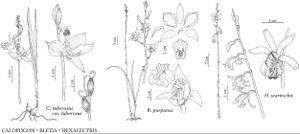Calopogon
in W. Aiton and W. T. Aiton, Hortus Kew. 5: 204. 1813.
| Taxon | Illustrator ⠉ | |
|---|---|---|
 | Calopogon tuberosus var. tuberosus Bletia purpurea Hexalectris warnockii | Barbara Alongi Barbara Alongi Barbara Alongi |
Herbs, perennial, terrestrial, scapose, sympodial. Roots from globose, ellipsoid, oblong, or forked corms, 0.5–2 mm wide. Stems: glabrous; cauline bracts 2–3, sheathing. Leaves 1 (–3), sessile; blade linear, lanceolate, or elliptic-lanceolate, conduplicate, frequently prominently veined. Inflorescences terminal, 1 (–3) racemose spikes, 1–25-flowered (ovaries not pedicellate despite appearance), scapose; flowers opening nearly simultaneously to sequentially; floral bracts subulate, lanceolate, or ovate, typically small. Flowers not resupinate, magenta, deep rose-pink, pale-pink, or white, sometimes fragrant, sessile; dorsal sepal lanceolate; lateral sepals ovate to nearly lanceolate, falcate, apex apiculate to acuminate; petals linear, ovate, elliptic, lanceolate, or oblanceolate, sometimes pandurate, clawed; lip basally hinged, obscurely 3-lobed, middle lobe distally dilated into triangular or broadly rounded lamina, large, lateral lobes 2, small; disc with 2–3 longitudinal lamellae grading distally into brush of hairlike protuberances; protuberances white, yellow, or orange to magenta, elongate, filiform to clavellate; column arcuate, broadly dilated at distal end; anther terminal, green to crimson; pollinia 4 in 2 pairs, soft and mealy; viscidium absent; pollen-grains in tetrads. Fruits capsules, erect, cylindric, ellipsoid, or obconic; column persistent in mature capsule.
Distribution
e North America, West Indies (Bahamas), West Indies (Cuba)
Discussion
Species 5 (5 in the flora).
Based on morphology and allozymes, D. W. Trapnell (1995) determined that all taxa she sampled, which did not include Calopogon oklahomensis and C. tuberosus var. latifolius, were properly circumscribed, although results were not strongly conclusive about relationships among the species. Based on DNA data, D. H. Goldman (2000) determined that C. multiflorus and C. pallidus are most closely related, although the relationships of the other taxa were not as certain. DNA evidence did support the circumscription of all taxa except C. tuberosus var. latifolius, which was in agreement with the work of P. M. Catling and Z. Lucas (1987). Plastid DNA sequences suggested that Calopogon is most closely related to the eastern North American genus Arethusa, and the Asian genera Anthogonium, Arundina, and Eleorchis (D. H. Goldman 2000; D. H. Goldman et al. 2001).
Calopogon appears to exhibit deceit pollination (L. van der Pijl and C. H. Dodson 1966; L. B. Thien and B. G. Marcks 1972; D. H. Firmage and F. R. Cole 1988; J. T. Boland and P. J. Scott 1991). This occurs when pollinating bees land on the lip and try to gather pollen off the large hairlike protuberances that resemble anthers. The weight of the pollinator causes the lip to fall, dropping the pollinator backwards onto the column; pollinia adhere to the back of the bee and subsequently are carried to another flower. Soft pollinia in Calopogon had been noted to be an evolutionary reversal to facilitate pollination by hairy bees (W. P. Stoutamire 1971).
Selected References
None.
Lower Taxa
Key
| 1 | Petals wider at distal half than at proximal half (distinctly pandurate); lip usually as wide as or wider than long; inflorescences dark purple; flowers pungent. | Calopogon multiflorus |
| 1 | Petals equal to or narrower at distal half than at proximal half; lip usually narrower than long; inflorescences green or slightly purple at base, rarely entirely purple; flowers scentless to mildly fragrant. | > 2 |
| 2 | Leaf appressed to inflorescence at flowering; flowers less than 1 cm apart, not fragrant, opening nearly simultaneously. | Calopogon barbatus |
| 2 | Leaf not appressed to inflorescence at flowering; flowers more than 1 cm apart, variously fragrant, opening nearly simultaneously to sequentially. | > 3 |
| 3 | Petals lanceolate to weakly pandurate, falcate; floral bracts 1.5–4.5 mm; lateral sepals 10–15 mm, falcate, widely spreading. | Calopogon pallidus |
| 3 | Petals obpandurate, slightly falcate to straight; floral bracts 3–12(–30) mm; lateral sepals 15–28 mm, weakly falcate to straight, occasionally spreading. | > 4 |
| 4 | Flowers opening sequentially; dilated distal portion of middle lip lobe usually much wider than long, typically anvil shaped; stigma at angle to column surface; corms globose to elongate, not forked. | Calopogon tuberosus |
| 4 | Flowers opening nearly simultaneously; dilated distal portion of middle lip lobe usually much narrower than long, triangular to broadly rounded; stigma typically flat against column surface; corms elongate, forked. | Calopogon oklahomensis |